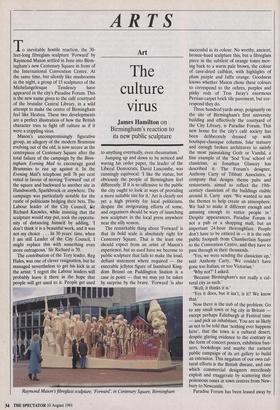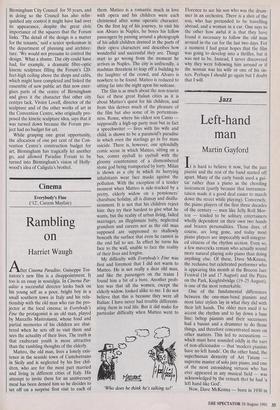ARTS
Art
The culture virus
James Hamilton on Birmingham's reaction to its new public sculpture To inevitable hostile reaction, the 30- feet-long fibreglass sculpture 'Forward' by Raymond Mason settled in June into Birm- ingham's new Centenary Square in front of the International Convention Centre. At the same time, but silently like mushrooms in the night, a group of 15 sculptures of the Michelangelesque Tendency have appeared in the city's Paradise Forum. This is the new name given to the café courtyard of the brutalist Central Library, in a wild attempt to make the centre of Birmingham feel like Heaven. These two developments are a perfect illustration of how the British character tries to fight off culture as if it were a crippling virus.
Mason's uncompromisingly figurative group, an allegory of the modern Brummie evolving out of the old, is now secure as the centrepiece of Centenary Square after the total failure of the campaign by the Birm- ingham Evening Mail to encourage good ,Brummies to rise up against it. In the Evening Mail's telephone poll 76 per cent voted in favour of moving 'Forward' out of the square and backward to another site in Handsworth, Sparkbrook or anywhere. The campaign was particularly notable for the rustle of politicians hedging their bets. The Labour leader of the City Council, Sir Richard Knowles, while insisting that the sculpture would stay put, took the opportu- nity of distancing himself by adding, 'I don't think it is a beautiful work, and it was not my choice . . . In 30 years' time, when I am still Leader of the City Council, I might replace this with something even more outrageous.' Sir Richard is 70.
The contribution of the Tory leader, Reg Hales, was one of clever resignation, but he managed nevertheless to get his kick in at the artist: 'I regret the Labour leaders will probably leave it there in the hope that people will get used to it. People get used to anything eventually, even rheumatism.'
Jumping up and down to be noticed and waving his order paper, the leader of the Liberal Democrats, David Luscombe, was cunningly equivocal: 'I like the statue, but obviously the people of Birmingham feel differently. If it is so offensive to the public the city ought to look at ways of providing a more suitable site for it.' Art is clearly not yet a high priority for local politicians, despite the invigorating efforts of some, and organisers should be wary of launching new sculpture in the local press anywhere near the silly season.
The remarkable thing about 'Forward' is that its bold scale is absolutely right for Centenary Square. That is the least one should expect from an artist of Mason's experience, but so used have we become to public sculpture that fails to make the loud, defiant statement where required — the execrable jellytot figure of Isambard King- dom Brunel on Paddington Station is a case in point — that we may yet be taken by surprise by the brave. 'Forward 'is also Raymond Mason's fibreglass sculpture, 'Forward, in Centenary Square, Birmingham successful in its colour. No worthy, ancient, bronze-hued sculpture this, but a fibreglass piece in the subtlest of orange tones mov- ing back to a warm pale brown, the colour of cave-dried calfskin, with highlights of plum purple and Jaffa orange. Goodness knows whether Mason chose these colours to correspond to the ochres, purples and pinky reds of Tess Jaray's enormous Persian-carpet brick tile pavement, but cor- respond they do.
Three hundred yards away, poignantly on the site of Birmingham's first university building and effectively the courtyard of the City Library, is Paradise Forum. This new home for the city's café society has been deliberately dressed up with boutique-classique columns, fake statuary and enough broken architraves to satisfy the most painstaking Goth or Vandal, a fine example of the 'Sod You' school of classicism, as Jonathan Glancey has described it. The Forum's designer, Anthony. Carty of Tibbatt Associates, a company that designs theme pubs and restaurants, aimed to reflect the 19th- century classicism of the buildings visible around it. Carty says: 'We wanted to mix the themes to help create an atmosphere. We had to make it different enough and amusing enough to entice people in.' Despite appearances, Paradise Forum is not a pub or a shopping mall, but an important 24-hour thoroughfare. People don't have to be enticed in — it is the only public footpath from Chamberlain Square to the Convention Centre, and they have to pass through in their thousands.
`Yes, we were sending the classicism up,' said Anthony Carty, 'We couldn't have gone too Italian, or too Victorian.'
`Why not?' I asked.
`Because Birmingham's not really a cul- tural city as such.'
`Well, it thinks it is.'
`Yes it does, but it isn't, is it? We know that.'
Now there is the nub of the problem. Go to any small town or big city in Britain except perhaps Edinburgh at Festival time — and pick an inhabitant. You are as likely as not to be told that 'nothing ever happens here', that the town is a cultural desert, despite glaring evidence to the contrary in the form of concert posters, exhibition ban- ners, bookshops and maybe the earnest public campaign of its art gallery to build an extension. This negation of our own cul- tural efforts is the British disease, and one which commercial designers mercilessly exploit and exaggerate by scattering their poisonous oases in town centres from New- bury to Newcastle.
Paradise Forum has been leased away by Birmingham City Council for 50 years, and in doing so the Council has also relin- quished any control it might have had over its appearance, despite the great civic importance of the squares that the Forum links. The detail of the design is a matter for the tenants,' said a senior spokesman in the department of planning and architec- ture. 'We would not presume to control the design.' What a shame. The city could have had, for example, a dramatic fibre-optic kinetic sculpture filling the Forum's 120- feet-high ceiling above the shops and cafés, which might have completed and linked the ensemble of new public art that now ener- gises parts of the centre of Birmingham and gives it the character that other city centres lack. Vivien Lovell, director of the sculpture and of the other works of art in the Convention Centre, who originally pro- posed the kinetic sculpture idea, says that it was turned down because the Forum pro- ject had no budget for art.
While grasping one great opportunity, the allocation of one per cent of the Con- vention Centre's construction budget for art, Birmingham has tragically let another go, and allowed Paradise Forum to be turned into Birmingham's vision of Holly- wood's idea of Caligula's brothel.



















































 Previous page
Previous page